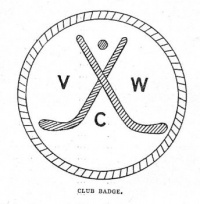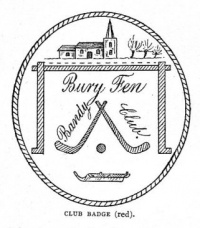1891-01-22: Virginia Water - Bury Fen 8:3
|
|
January 22, 1891 - Friendly match
(1:0, 7:3)
|
| ||||||||||
|
Squad:
|
| ||||
Match details
This match was extremely important in the development of ice hockey in Britain. It was the first time the Bury Fen squad left their native Fens to face a team from another part of England. The London team they met was a combination side that was officially known as the "Virginia Water Team". Most of the players were from the Virginia Water Hockey Club. It was also the first time that the contrasting styles of play - the National Skating Association had published two sets of rules for the Fen and Metropolitan (London) districts in 1883 - met head-on.
The match was a 90-minute affair, two periods of 45 minutes each. There were eleven players on each team and the playing surface (Virginia Water Lake) was much smaller than what the Fen players were accustomed to. The Londoners used figure skates, the Fenners "fen runners". To make it fair for both sides, the preferred rules from each region were used for a half. The first half was played under Metropolitan rules (strict off-side rule, light ash sticks, and a flat brewer's bung, covered with leather). In the second half Fen rules were employed (no off-side rule, large broad flat sticks and a round india-rubber ball).
The game provided the impetus for the formation of the National Bandy Association barely two weeks later, on February 9, 1891. It was clear that a unified set of rules were needed for the sport, and the goal of the association was stated as being to "promote bandy, or hockey on the ice" and to "draw up general rules for the game".
Contemporary accounts
Charles Goodman Tebbutt of the Bury Fen club wrote the following in Skating (1892):
During the winter of 1890-91 several matches were played near London, the principal being Virginia Water v. Mr. G. E. B. Kennedy's eleven, which was closely contested, victory falling to Virginia Water, two goals to one. After this a combination team was chosen to meet the Bury Fen Club, under the captaincy of H. Blackett, and called 'The Virginia Water Team'. For the first time the club left their native fens for the metropolis, and met on Virginia Water the representative London team. As a thaw had set in it was impossible to obtain as wide a piece of ice as is desirable. Some of the Londoners had been used to the leather- covered bung and light ash sticks, so the first half was played with these, during which the Londoners obtained one goal. At half-time the bandy and ball were played with, and the 'off-side rule', to which the Fenmen were unused, was agreed upon. The Londoners increased their goals by eight, whilst the Bury Fen club only made three. It was a very fast game throughout, the home side including some of the best hockey players of England, showing great speed, combination, and hitting power.
The teams consisted of, Bury Fen: W. Minson (goal); R. Goodman (capt), A. Tebbutt, L. Tebbutt (backs); F. Jewson, B. B. Tarring (half-backs); J. Goodman, C. G. Tebbutt, H. Wadsworth, Murphy, and H. Murphy (forwards). Londoners: R. P. Sewell, S. King Farlow, V. L. Oliver (backs); M. M. Barker, A. King Farlow, A. C. Hall (half-backs); J. Ward, G. E. B. Kennedy, H. Blackett (capt.), (forwards); and Percy Laming. In consequence of the great interest this match created, and the necessity of having uniform rules now that bandy was becoming general, a meeting of bandy players was held to consider rules and form a Bandy Association."
Another quote from Neville Tebbutt, featured in A Handbook of Bandy; or, Hockey on the Ice (1896):
"As yet there had been no encounter between the players of the Eastern counties and those of the London or South London district; and they hardly knew more of each other than the bare fact of existence. In 1890, however, Dr. Roger Goodman, a son of Mr. Neville Goodman, having gone to reside at Kingston, and having become acquainted with the doings of the Virginia Water Club, arranged a match between that club and a fen team, which was played on Virginia Water on January 22nd, 1891.
The visiting team was composed of Bury Fen men, and were captained by Dr. Goodman. When they arrived upon the ground, armed with their broad ash bandies, a difficulty at once arose from the difference in the rules and manner of play of the two teams. It was decided to play the first half of the time with the sticks and bung, under the rules of the home team; the latter half with the bandies and ball of the visitors. During the first half the fen men did not have a very comfortable time of it, and were beaten by one goal to none. If they expected to have their revenge during the second half of the time they must have been sadly disappointed. The home team took very kindly to the new form of warfare, and easily beat the fen men with their own weapons.
Various excuses were given by the friends of the visitors for their defeat, some of which were, no doubt, well founded. One of the chief reasons, however, was that, while the fen men to a great extent played each for himself, their opponents played a clever combined game, which, at any rate, on ground of the size played on, made the irresistible.
The game was the death blow of the stick and bung game, for most of the Virginia Water players admitted that the bandy and ball was the best game of the two, while not a fen player could ever have been induced to use the sticks and bung again."
Sydney Farlow of Virginia Water wrote in Ice Sports (1901):
"Mention, also must be made of the progress made by the game in the Virginia Water and Windsor district between 1873 and 1891, and the form it took in this part of the country. Its progress was due to the efforts of one keen and admirable player – Mr. Harold Blackett – who, with untiring energy, brought together the local talent, including Messrs. Kennedy, Ward, Hargreaves, Oliver, King Farlow, Waterer, Rigden, Playford, Rivett-Carnac, Kilby, and Sir Geo. Pigot, and formed the Virginia Water Club. He brought off matches in all directions in the neighbourhood, saw his team gradually develop combination and passing, and helped them on to victory against the famous Bury Fenmen in January, 1891.
Up to this date the Virginia Water men played with a light ash stick in lieu of a bandy, and a bung instead of a ball; and a very pretty game it was, with long hard hitting practically out of the question, and plenty of scope for short and accurate passing and dribbling, and pace in addition. But this famous match sealed the fate of the stick and bung; every one had to agree with the Fenmen that their larger bandy was the proper implement, while the ball, too, was recognized as possessing advantages over the bung, whether leather covered or not.
Land hockey players, of course, were on the side of the Fenmen, and, as not a few of them were towers of strength in the Virginia Water Team, opposition to the change was lacking when representatives of the leading clubs interested in bandy met to discuss the game."

